Analysis of Vestibular Labyrinthine Geometry and Variation in the Human Temporal Bone
- PMID: 29535601
- PMCID: PMC5834493
- DOI: 10.3389/fnins.2018.00107
Analysis of Vestibular Labyrinthine Geometry and Variation in the Human Temporal Bone
Abstract
Stable posture and body movement in humans is dictated by the precise functioning of the ampulla organs in the semi-circular canals. Statistical analysis of the interrelationship between bony and membranous compartments within the semi-circular canals is dependent on the visualization of soft tissue structures. Thirty-one human inner ears were prepared, post-fixed with osmium tetroxide and decalcified for soft tissue contrast enhancement. High resolution X-ray microtomography images at 15 μm voxel-size were manually segmented. This data served as templates for centerline generation and cross-sectional area extraction. Our estimates demonstrate the variability of individual specimens from averaged centerlines of both bony and membranous labyrinth. Centerline lengths and cross-sectional areas along these lines were identified from segmented data. Using centerlines weighted by the inverse squares of the cross-sectional areas, plane angles could be quantified. The fit planes indicate that the bony labyrinth resembles a Cartesian coordinate system more closely than the membranous labyrinth. A widening in the membranous labyrinth of the lateral semi-circular canal was observed in some of the specimens. Likewise, the cross-sectional areas in the perilymphatic spaces of the lateral canal differed from the other canals. For the first time we could precisely describe the geometry of the human membranous labyrinth based on a large sample size. Awareness of the variations in the canal geometry of the membranous and bony labyrinth would be a helpful reference in designing electrodes for future vestibular prosthesis and simulating fluid dynamics more precisely.
Keywords: centerlines; inner ear; membranous labyrinth; microCT; semi-circular canals; vestibular labyrinth.
Figures
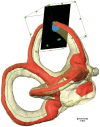

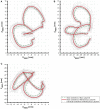
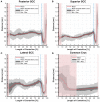
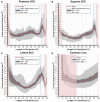
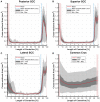

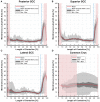
Similar articles
-
Visualization of the Membranous Labyrinth and Nerve Fiber Pathways in Human and Animal Inner Ears Using MicroCT Imaging.Front Neurosci. 2018 Jul 31;12:501. doi: 10.3389/fnins.2018.00501. eCollection 2018. Front Neurosci. 2018. PMID: 30108474 Free PMC article.
-
Bony labyrinth shape variation in extant Carnivora: a case study of Musteloidea.J Anat. 2016 Mar;228(3):366-83. doi: 10.1111/joa.12421. Epub 2015 Nov 18. J Anat. 2016. PMID: 26577069 Free PMC article.
-
The role of 3-canal biomechanics in angular motion transduction by the human vestibular labyrinth.Ann Biomed Eng. 2007 Jul;35(7):1247-63. doi: 10.1007/s10439-007-9277-y. Epub 2007 Mar 22. Ann Biomed Eng. 2007. PMID: 17377842 Free PMC article.
-
Evolutionary changes in the cochlea and labyrinth: Solving the problem of sound transmission to the balance organs of the inner ear.Anat Rec A Discov Mol Cell Evol Biol. 2006 Apr;288(4):482-9. doi: 10.1002/ar.a.20306. Anat Rec A Discov Mol Cell Evol Biol. 2006. PMID: 16552774 Review.
-
Labyrinthine fistulae: pathobiology and management.Curr Opin Otolaryngol Head Neck Surg. 2003 Oct;11(5):340-6. doi: 10.1097/00020840-200310000-00006. Curr Opin Otolaryngol Head Neck Surg. 2003. PMID: 14502064 Review.
Cited by
-
Growth and cellular patterning during fetal human inner ear development studied by a correlative imaging approach.BMC Dev Biol. 2019 May 20;19(1):11. doi: 10.1186/s12861-019-0191-y. BMC Dev Biol. 2019. PMID: 31109306 Free PMC article.
-
Enhanced contrast in X-ray microtomographic images of the membranous labyrinth using different X-ray sources and scanning modes.J Anat. 2018 Dec;233(6):770-782. doi: 10.1111/joa.12885. Epub 2018 Oct 2. J Anat. 2018. PMID: 30277260 Free PMC article.
-
IE-Map: a novel in-vivo atlas and template of the human inner ear.Sci Rep. 2021 Feb 8;11(1):3293. doi: 10.1038/s41598-021-82716-0. Sci Rep. 2021. PMID: 33558581 Free PMC article. Clinical Trial.
-
Validation of RNA Extraction Methods and Suitable Reference Genes for Gene Expression Studies in Developing Fetal Human Inner Ear Tissue.Int J Mol Sci. 2024 Mar 2;25(5):2907. doi: 10.3390/ijms25052907. Int J Mol Sci. 2024. PMID: 38474154 Free PMC article.
-
Visualization of the Membranous Labyrinth and Nerve Fiber Pathways in Human and Animal Inner Ears Using MicroCT Imaging.Front Neurosci. 2018 Jul 31;12:501. doi: 10.3389/fnins.2018.00501. eCollection 2018. Front Neurosci. 2018. PMID: 30108474 Free PMC article.
References
-
- Bradshaw A. P., Curthoys I. S., Todd M. J., Magnussen J. S., Taubman D. S., Aw S. T., et al. . (2010). A mathematical model of human semicircular canal geometry: a new basis for interpreting vestibular physiology. J. Assoc. Res. Otolaryngol. 11, 145–159. 10.1007/s10162-009-0195-6 - DOI - PMC - PubMed
LinkOut - more resources
Full Text Sources
Other Literature Sources

